Stable and Low-Spurs Optoelectronic Oscillators: A Review
Abstract
1. Introduction
2. Optoelectronic Oscillators
3. Improvement of Optoelectronic Oscillators
3.1. Spurious Suppression
3.2. Frequency Stabilization
4. Conclusions
Author Contributions
Funding
Conflicts of Interest
References
- Chirikov, B.V. A universal instability of many-dimensional oscillator systems. Phys. Rep. 1979, 52, 263–379. [Google Scholar] [CrossRef]
- Sazonova, V.; Yaish, Y.; Üstünel, H. A tunable carbon nanotube electromechanical oscillator. Nature 2004, 431, 284–287. [Google Scholar] [CrossRef]
- Roh, W.; Seol, J.Y.; Park, J.; Lee, B.; Kim, Y.; Aryanfar, F. Millimeter-wave beamforming as an enabling technology for 5G cellular communications: Theoretical feasibility and prototype results. IEEE Commun. Mag. 2014, 52, 106–113. [Google Scholar] [CrossRef]
- Scheer, J.A.; Kurtz, J.L. Coherent Radar Performance Estimation; Artech House: Norwood, MA, USA, 1993. [Google Scholar]
- Vig, J.R. Military applications of high accuracy frequency standards and clocks. IEEE Trans Ultrason. Ferroelectr. Freq. Control 1993, 40, 522–527. [Google Scholar] [CrossRef] [PubMed]
- Da Dalt, N.; Harteneck, M.; Sandner, C.; Wiesbauer, A. On the jitter requirements of the sampling clock for analog-to-digital converters. IEEE Trans. Circuits Syst. I Fundam. Theory Appl. 2002, 49, 1354–1360. [Google Scholar] [CrossRef]
- Shoop, B. Photonic Analog-to-Digital Conversion; Springer: Berlin, Germany, 2001. [Google Scholar]
- Weyers, S.; Lipphardt, B.; Schnatz, H. Reaching the quantum limit in a fountain clock using a microwave oscillator phase locked to an ultra-stable laser. Phys. Rev. A 2009, 79, 031803. [Google Scholar] [CrossRef]
- Clark, T.R.; Carruthers, T.F.; Matthews, P.J.; Duling, I.N. Phase noise measurements of ultra-stable 10 GHz harmonically mode-locked fiber laser. Electron. Lett. 1999, 35, 720–721. [Google Scholar] [CrossRef]
- Holloway, C.L.; Simons, M.T.; Gordon, J.A.; Wilson, P.F.; Cooke, C.M.; Anderson, D.A.; Raithel, G. Atom-based RF electric field metrology: From self-calibrated measurements to subwavelength and near-field imaging. IEEE Trans. Electromagn. Compat. 2017, 59, 717–728. [Google Scholar] [CrossRef]
- Sartorius, B. All-optical clock recovery for 3R optical regeneration. In Proceedings of the Optical Fiber Communication Conference, Anaheim, CA, USA, 17 March 2001. [Google Scholar]
- Drexhage, K.H. Influence of a dielectric interface on fluorescence decay time. J. Lumin. 1970, 1, 693–701. [Google Scholar] [CrossRef]
- Kajfez, D.; Guillon, P. Dielectric Resonators; Artech House, Inc.: Norwood, MA, USA, 1986. [Google Scholar]
- Filler, R.L. The acceleration sensitivity of quartz crystal oscillators: A review. IEEE Trans. Ultrason. Ferroelectr. Freq. Control 1988, 35, 297–305. [Google Scholar] [CrossRef] [PubMed]
- Vig, J.R. Quartz crystal resonators and oscillators for frequency control and timing applications. A tutorial. NASA STI/Recon Tech. Rep. N 1994, 9. [Google Scholar]
- Capmany, J.; Novak, D. Microwave photonics combines two worlds. Nat. Photonics 2007, 1, 319. [Google Scholar] [CrossRef]
- Yao, X.S.; Maleki, L. Optoelectronic microwave oscillator. J. Opt. Soc. Am. B Opt. Phys. 1996, 13, 1725–1735. [Google Scholar] [CrossRef]
- Yao, X.S.; Maleki, L. Optoelectronic oscillator for photonic systems. IEEE J. Quantum Electron. 1996, 32, 1141–1149. [Google Scholar] [CrossRef]
- Maleki, L. Sources: The optoelectronic oscillator. Nat. Photonics 2011, 5, 728–730. [Google Scholar] [CrossRef]
- Eliyahu, D.; Seidel, D.; Maleki, L. Phase noise of a high performance OEO and an ultra-low noise floor cross-correlation microwave photonic homodyne system. In Proceedings of the IEEE Conference on International Frequency Control Symposium, Honolulu, HI, USA, 19–21 May 2008; pp. 811–814. [Google Scholar]
- Devgan, P. A review of optoelectronic oscillators for high speed signal processing applications. ISRN Electron. 2013, 2013, 1–16. [Google Scholar] [CrossRef]
- Eliyahu, D.; Seidel, D.; Maleki, L. RF amplitude and phase-noise reduction of an optical link and an opto-electronic oscillator. IEEE Trans. Inf. Theory 2008, 56, 449–456. [Google Scholar] [CrossRef]
- Kim, J.Y.; Jo, J.H.; Choi, W.Y.; Sung, H.K. Dual-loop dual-modulation optoelectronic oscillators with highly suppressed spurious tones. IEEE Photonics Technol. Lett. 2012, 24, 706. [Google Scholar] [CrossRef]
- Romisch, S.; Kitching, J.; Ferre-Pikal, E. Performance evaluation of an optoelectronic oscillator. IEEE Trans. Ultrason. Ferroelectr. Freq. Control 2000, 47, 1159–1165. [Google Scholar] [CrossRef]
- Zhu, D.; Pan, S.; Ben, D. Tunable frequency-quadrupling dual-loop optoelectronic oscillator. IEEE Photonics Technol. Lett. 2012, 24, 194–196. [Google Scholar] [CrossRef]
- Eliyahu, D.; Maleki, L. Tunable, ultra-low phase noise YIG based opto-electronic oscillator. In Proceedings of the IEEE MTT-S International Microwave Symposium, Philadelphia, PA, USA, 8–13 June 2003; pp. 2185–2187. [Google Scholar]
- Ilchenko, V.S.; Byrd, J.; Savchenkov, A.A.; Matsko, A.B.; Seidel, D.; Maleki, L. Miniature oscillators based on optical whispering gallery mode resonators. In Proceedings of the IEEE International Frequency Control Symposium, Honolulu, HI, USA, 19–21 May 2008; pp. 305–308. [Google Scholar]
- Zhou, P.; Zhang, F.; Pan, S. A multi-frequency optoelectronic oscillator based on a single phase-modulator. In Proceedings of the Conference on Lasers and Electro-Optics, San Jose, CA, USA, 10–15 May 2015. [Google Scholar]
- Hosseini, S.E.; Banai, A. Analytical Prediction of the Main Oscillation Power and Spurious Levels in Optoelectronic Oscillators. J. Lightwave Technol. 2014, 32, 978–985. [Google Scholar] [CrossRef]
- Swanson, D.; Macchiarella, G. Microwave filter design by synthesis and optimization. IEEE Microw. Mag. 2007, 8, 55–69. [Google Scholar] [CrossRef]
- Bogataj, L.; Vidmar, M.; Batagelj, B. Opto-Electronic Oscillator with Quality Multiplier. IEEE Trans. Microw. Theory Tech. 2016, 64, 663–668. [Google Scholar] [CrossRef]
- Yao, X.S.; Maleki, L. Dual microwave and optical oscillator. Opt. Lett. 1997, 22, 1867–1869. [Google Scholar] [CrossRef] [PubMed]
- Yao, X.S.; Davis, L.; Maleki, L. Coupled optoelectronic oscillators for generating both RF signal and optical pulses. J. Lightwave Technol. 2000, 18, 73–78. [Google Scholar] [CrossRef]
- Sung, H.K.; Lau, E.K.; Wu, M.C. Optical single sideband modulation using strong optical injection-locked semiconductor lasers. IEEE Photonics Technol. Lett. 2007, 19, 1005–1007. [Google Scholar] [CrossRef]
- Dai, J.; Dai, Y.; Yin, F.; Zhou, Y.; Li, J.; Fan, Y.; Xu, K. Compact optoelectronic oscillator based on a Fabry–Perot resonant electro-optic modulator. Chin. Opt. Lett. 2016, 14, 110701. [Google Scholar]
- Yang, J.; Jin-Long, Y.; Yao-Tian, W.; Li-Tai, Z.; En-Ze, Y. An optical domain combined dual-loop optoelectronic oscillator. IEEE Photonics Technol. Lett. 2007, 19, 807–809. [Google Scholar] [CrossRef]
- Cho, J.; Kim, H.; Sung, H. Reduction of spurious tones and phase noise in dual-loop OEO by loop-gain control. IEEE Photonics Technol. Lett. 2015, 27, 1391–1393. [Google Scholar] [CrossRef]
- Dai, Y.; Wang, R.; Yin, F.; Dai, J.; Yu, L.; Li, J.; Xu, K. Side-mode suppression for coupled optoelectronic oscillator by optical pulse power feedforward. Opt. Express 2015, 23, 27589–27596. [Google Scholar] [CrossRef]
- Dai, J.; Liu, A.; Liu, J.; Zhang, T.; Zhou, Y.; Yin, F.; Dai, Y.; Liu, Y.; Xu, K. Supermode noise suppression with mutual injection locking for coupled optoelectronic oscillator. Opt. Express 2017, 25, 27060–27066. [Google Scholar] [CrossRef] [PubMed]
- Fleyer, M.; Sherman, A.; Horowitz, M.; Namer, M. Wideband-frequency tunable optoelectronic oscillator based on injection locking to an electronic oscillator. Opt. Lett. 2016, 41, 1993–1996. [Google Scholar] [CrossRef] [PubMed]
- Okusaga, O.; Adles, E.J.; Levy, E.C.; Zhou, W.; Carter, G.M.; Menyuk, C.R.; Horowitz, M. Spurious mode reduction in dual injection-locked optoelectronic oscillators. Opt. Exp. 2016, 19, 5839–5854. [Google Scholar] [CrossRef] [PubMed]
- Strekalov, D.; Aveline, D.; Yu, N.; Thompson, R.; Matsko, A.B.; Maleki, L. Stabilizing an optoelectronic microwave oscillator with photonic filters. J. Lightwave Technol. 2003, 21, 3052–3061. [Google Scholar] [CrossRef]
- Bagnell, M.; Davila-Rodriguez, J.; Delfyett, P.J. Millimeter-wave generation in an optoelectronic oscillator using an ultrahigh finesse etalon as a photonic filter. J. Lightwave Technol. 2014, 32, 1063–1067. [Google Scholar] [CrossRef]
- Liu, A.; Liu, J.; Dai, J.; Dai, Y.; Yin, F.; Li, J.; Zhou, Y.; Zhang, T.; Xu, K. Spurious Suppression in Millimeter-Wave OEO with a High-Q Optoelectronic Filter. IEEE Photonics Technol. Lett. 2017, 29, 1671–1674. [Google Scholar] [CrossRef]
- Eliyahu, D.; Sariri, K.; Kamran, A.; Tokhmakhian, M. Improving short and long term frequency stability of the optoelectronic oscillator. In Proceeding of the IEEE Conference on International Frequency Control Symposium and PDA Exhibition Jointly, New Orleans, LA, USA, 31 May 2002; pp. 580–583. [Google Scholar]
- Kaba, M.; Li, H.W.; Daryoush, A.S.; Vilcot, J.P.; Decoster, D.; Chazelas, J.; Bouwmans, G.; Quiquempois, Y.; Deborgies, F. Improving thermal stability of optoelectronic oscillators. IEEE Microw. Mag. 2006, 7, 38–47. [Google Scholar] [CrossRef]
- Yao, X.S.; Maleki, L. Multi-loop optoelectronic oscillator. IEEE J. Quantum Electron. 2000, 36, 79–84. [Google Scholar] [CrossRef]
- Eliyahu, D.; Sariri, K.; Taylor, J.; Maleki, L. Optoelectronic oscillator with improved phase noise and frequency stability. In Proceedings of the International Society for Optics and Photonics: Photonic Integrated Systems, San Jose, CA, USA, 28–30 January 2003; Volume 4998, pp. 139–148. [Google Scholar]
- Zhang, Y.; Hou, D.; Zhao, J. Long-term frequency stabilization of an optoelectronic oscillator using phase-locked loop. J. Lightwave Technol. 2014, 32, 2408–2414. [Google Scholar] [CrossRef]
- Xu, X.; Dai, J.; Dai, Y.; Yin, F.; Zhou, Y.; Li, J.; Yin, J.; Wang, Q.; Xu, K. Broadband and wide-range feedback tuning scheme for phase-locked loop stabilization of tunable optoelectronic oscillators. Opt. Lett. 2015, 40, 5858–5861. [Google Scholar] [CrossRef] [PubMed]
- Bluestone, A.; Spencer, D.T.; Srinivasan, S.; Guerra, D.; Bowers, J.E.; Theogarajan, L. An ultra-low phase-noise 20-GHz PLL utilizing an optoelectronic voltage-controlled oscillator. IEEE Trans. Microw. Theory Tech. 2015, 63, 1046–1052. [Google Scholar] [CrossRef]
- Dai, J.; Zhao, Z.; Zeng, Y.; Liu, J.; Liu, A.; Zhang, T.; Yin, F.; Zhou, Y.; Liu, Y.; Xu, K. Stabilized Optoelectronic Oscillator with Enlarged Frequency-drift Compensation Range. IEEE Photonics Technol. Lett. 2018, 30, 1289–1292. [Google Scholar] [CrossRef]
- Liu, J.; Liu, A.; Wu, Z.; Gao, Y.; Dai, J.; Liu, Y.; Xu, K. Frequency-demultiplication OEO for stable millimeter-wave signal generation utilizing phase-locked frequency-quadrupling. Opt. Express 2018, 26, 27358–27367. [Google Scholar] [CrossRef] [PubMed]

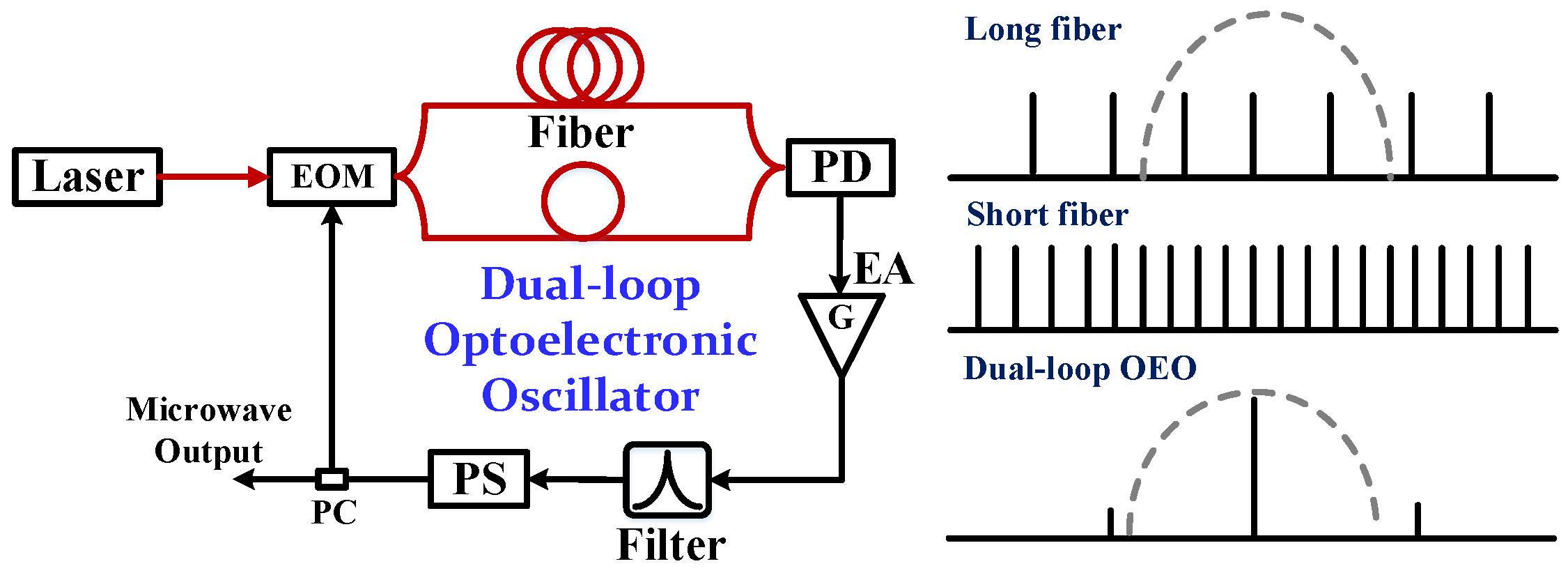

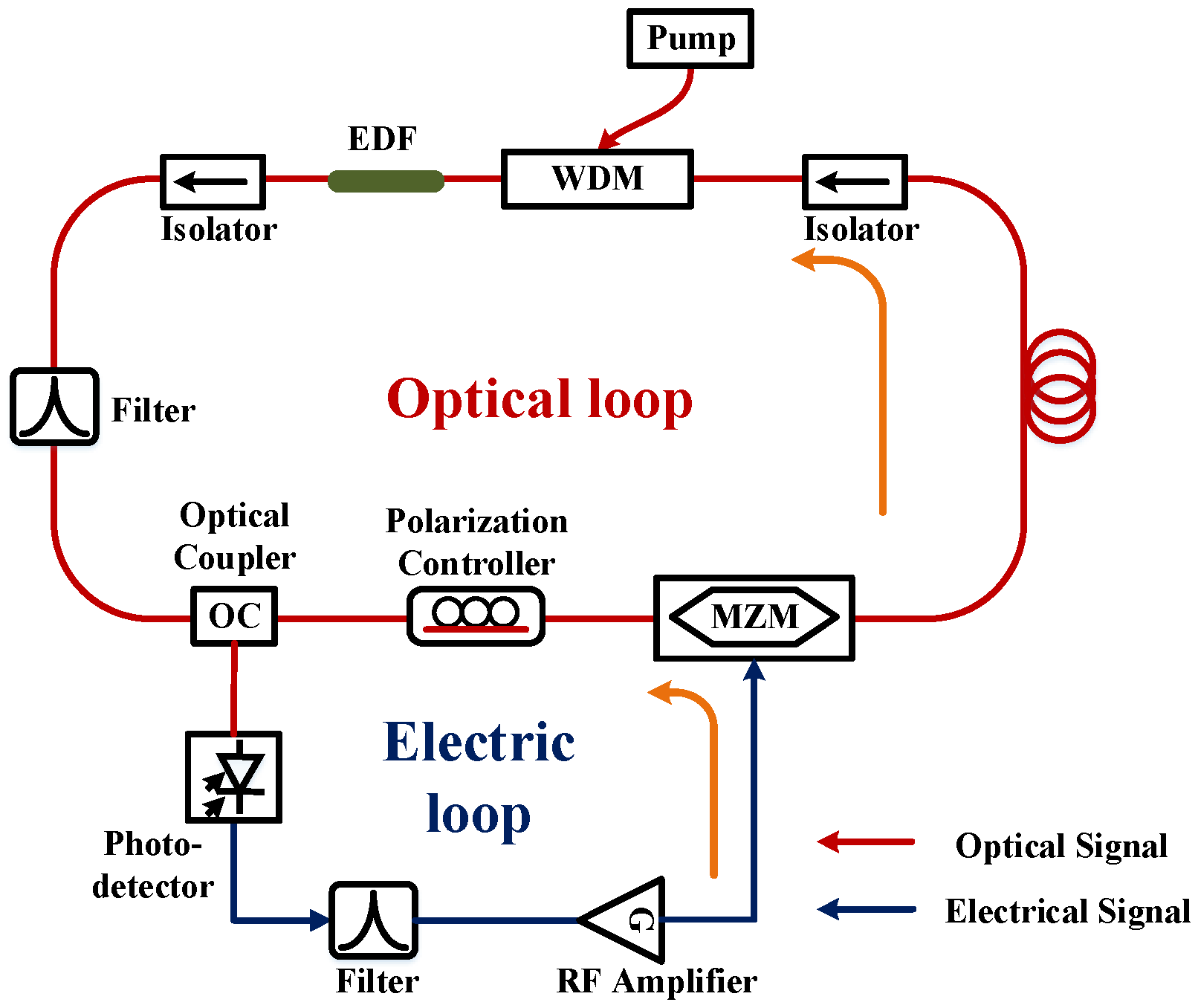
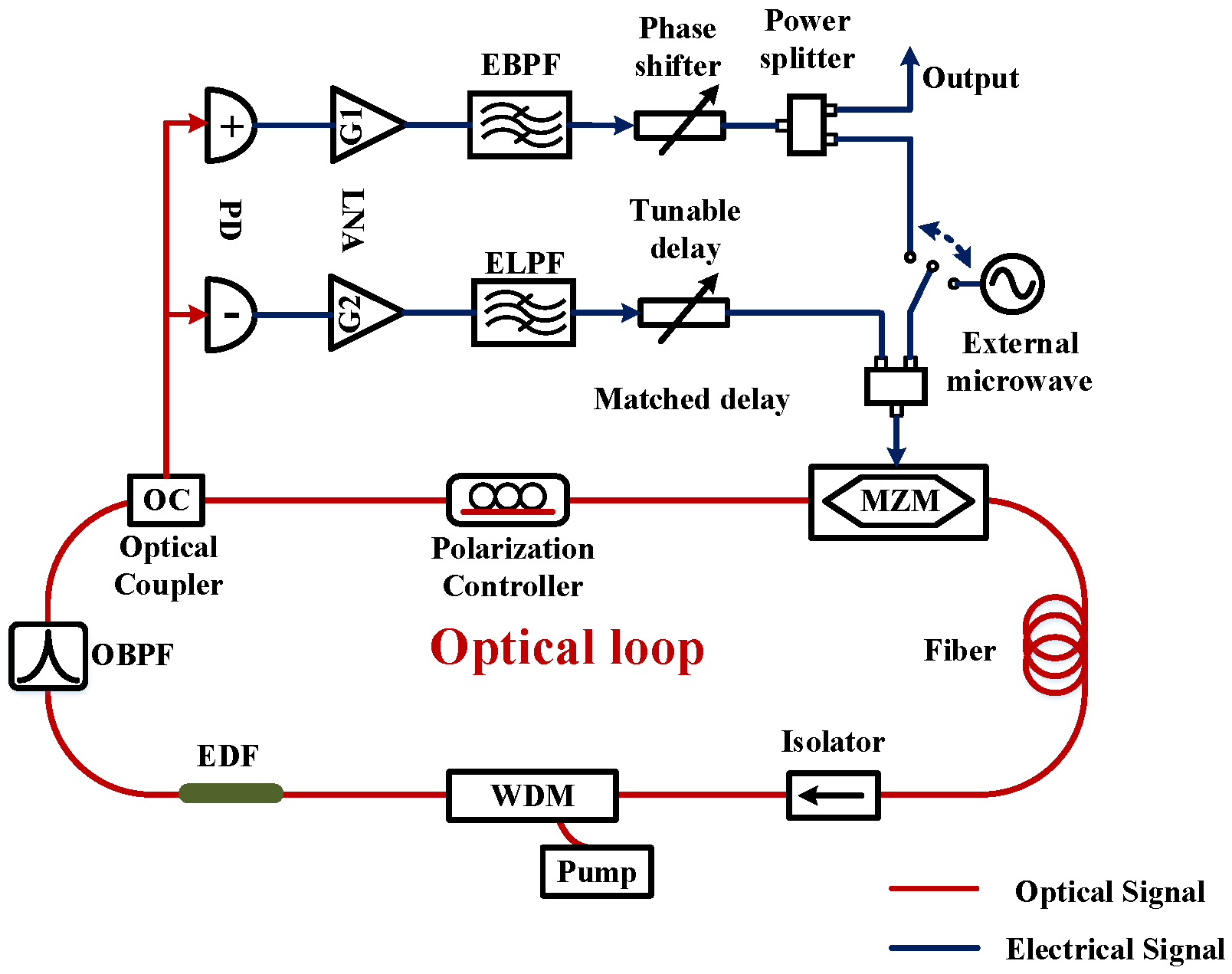
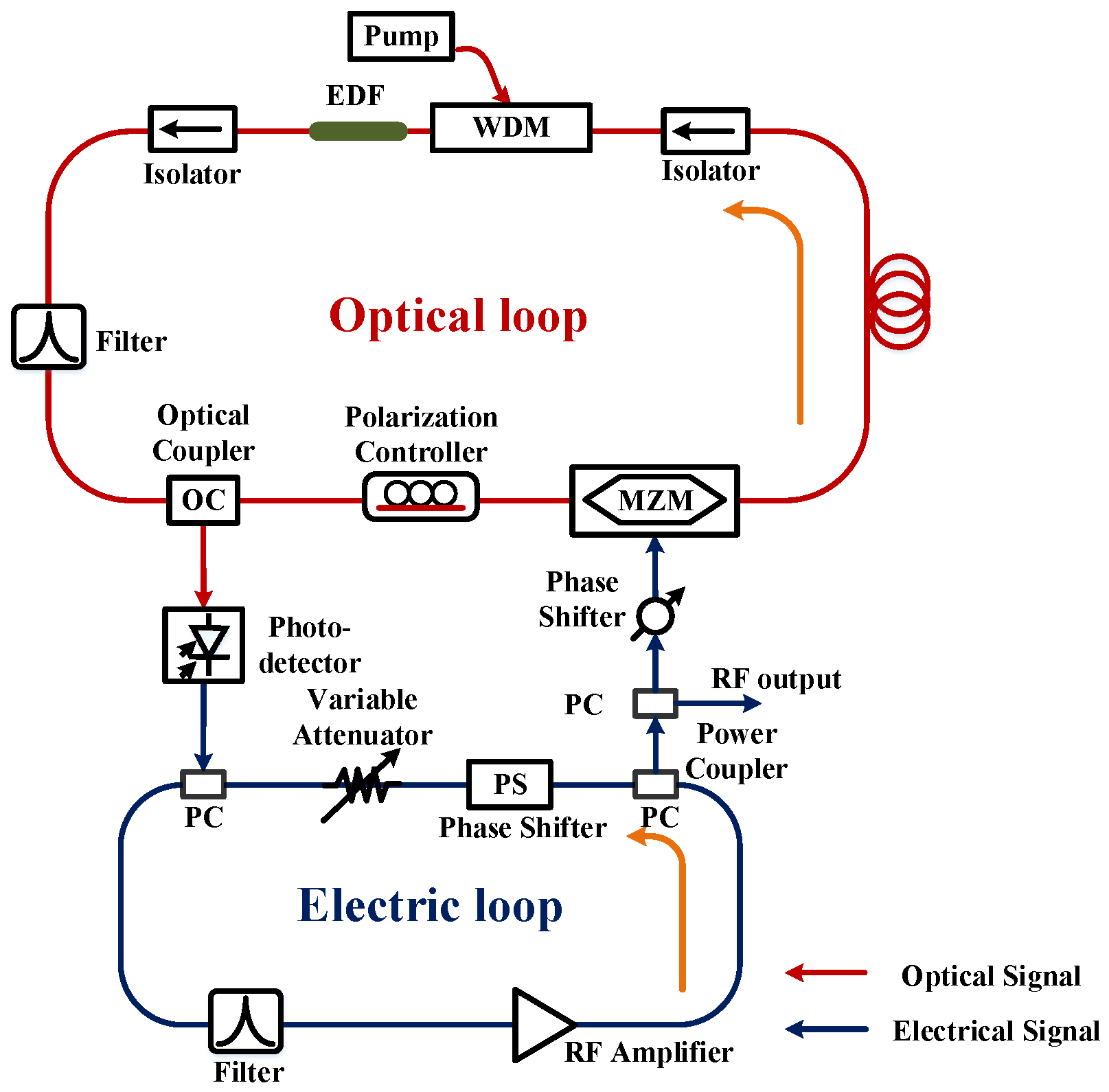
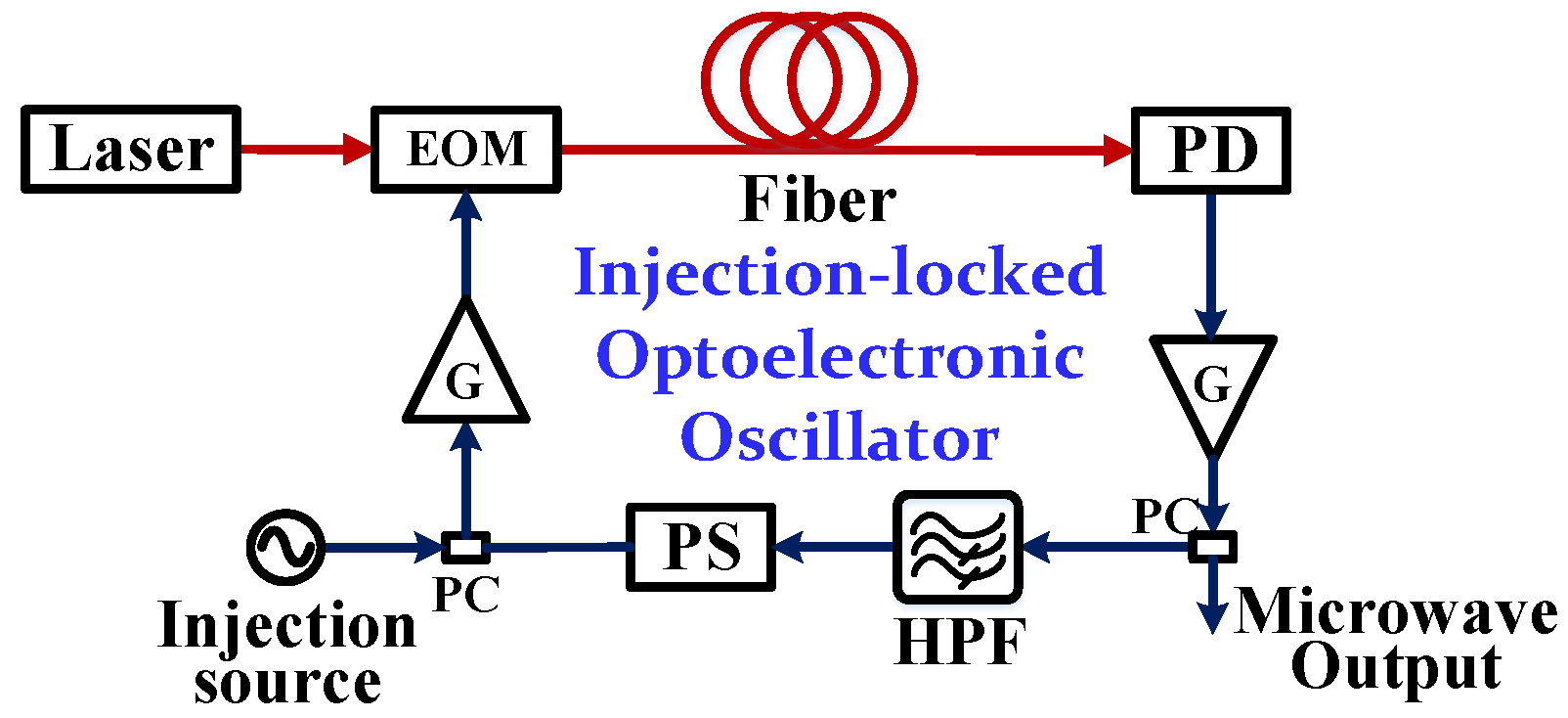
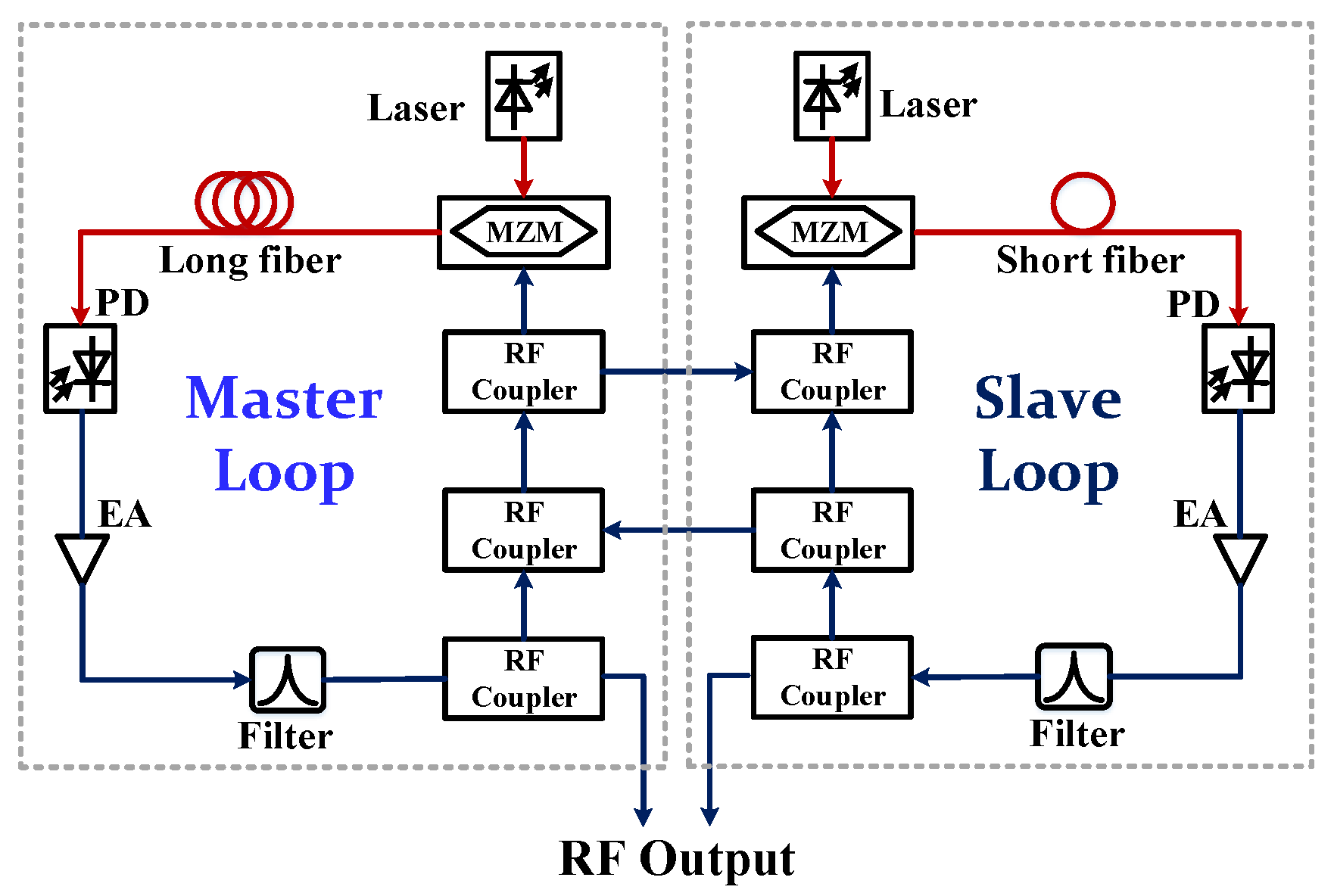
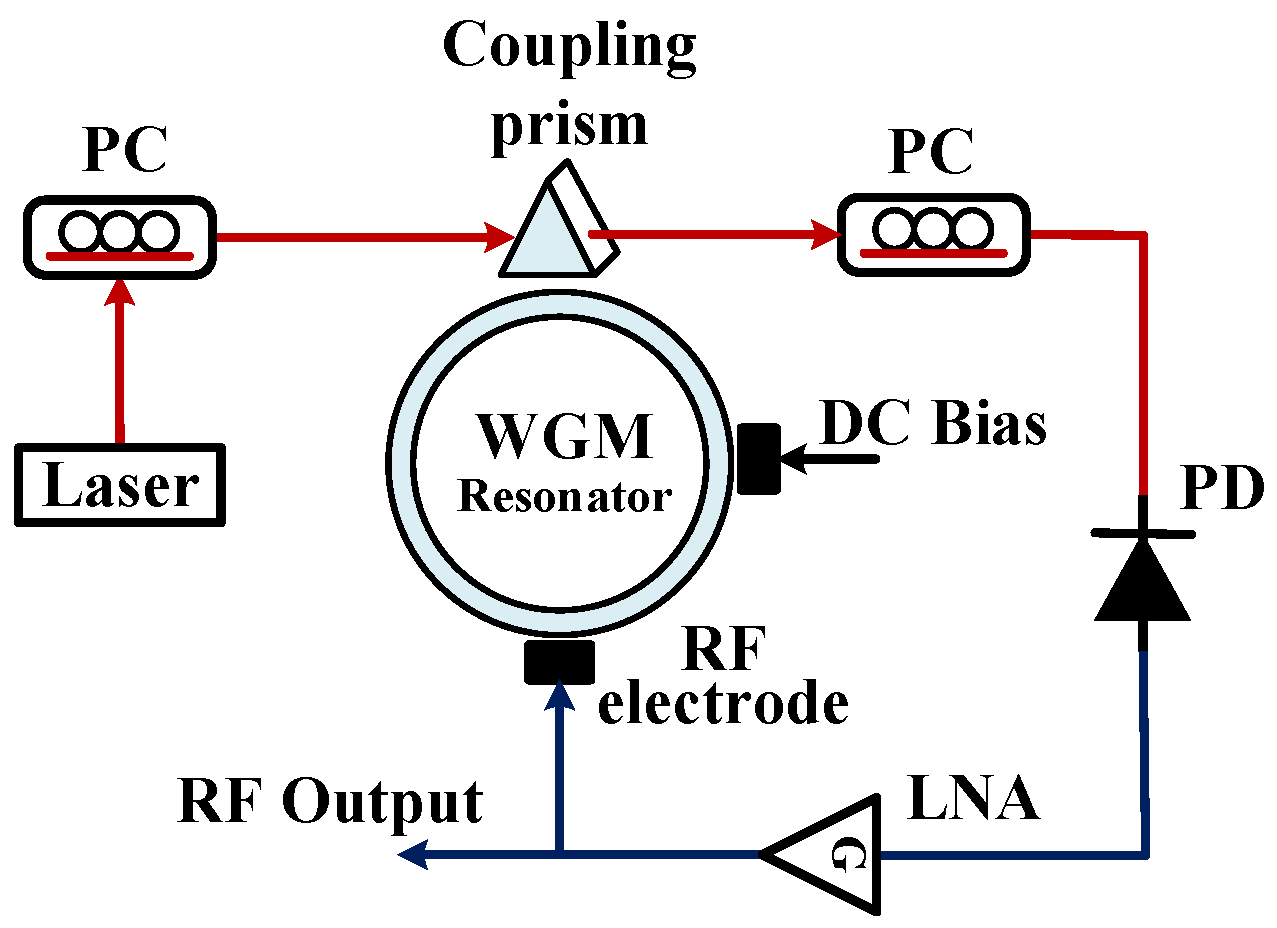
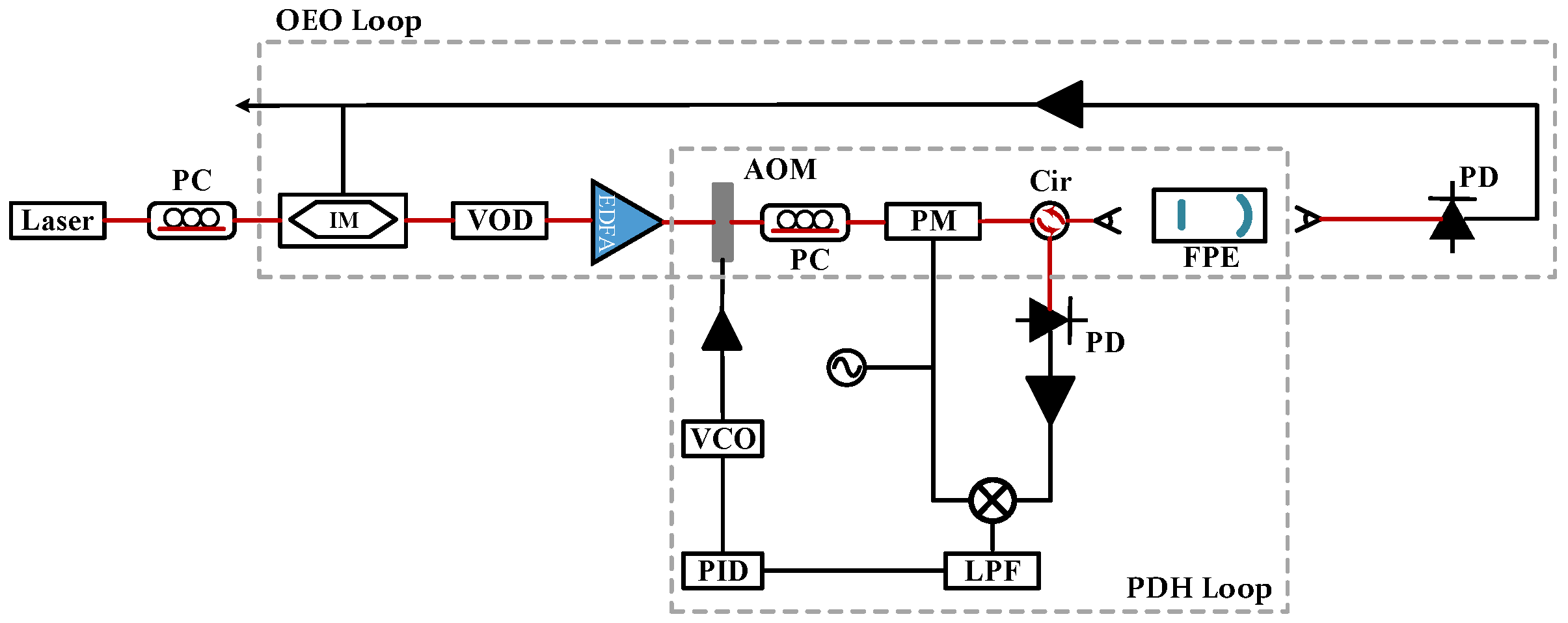
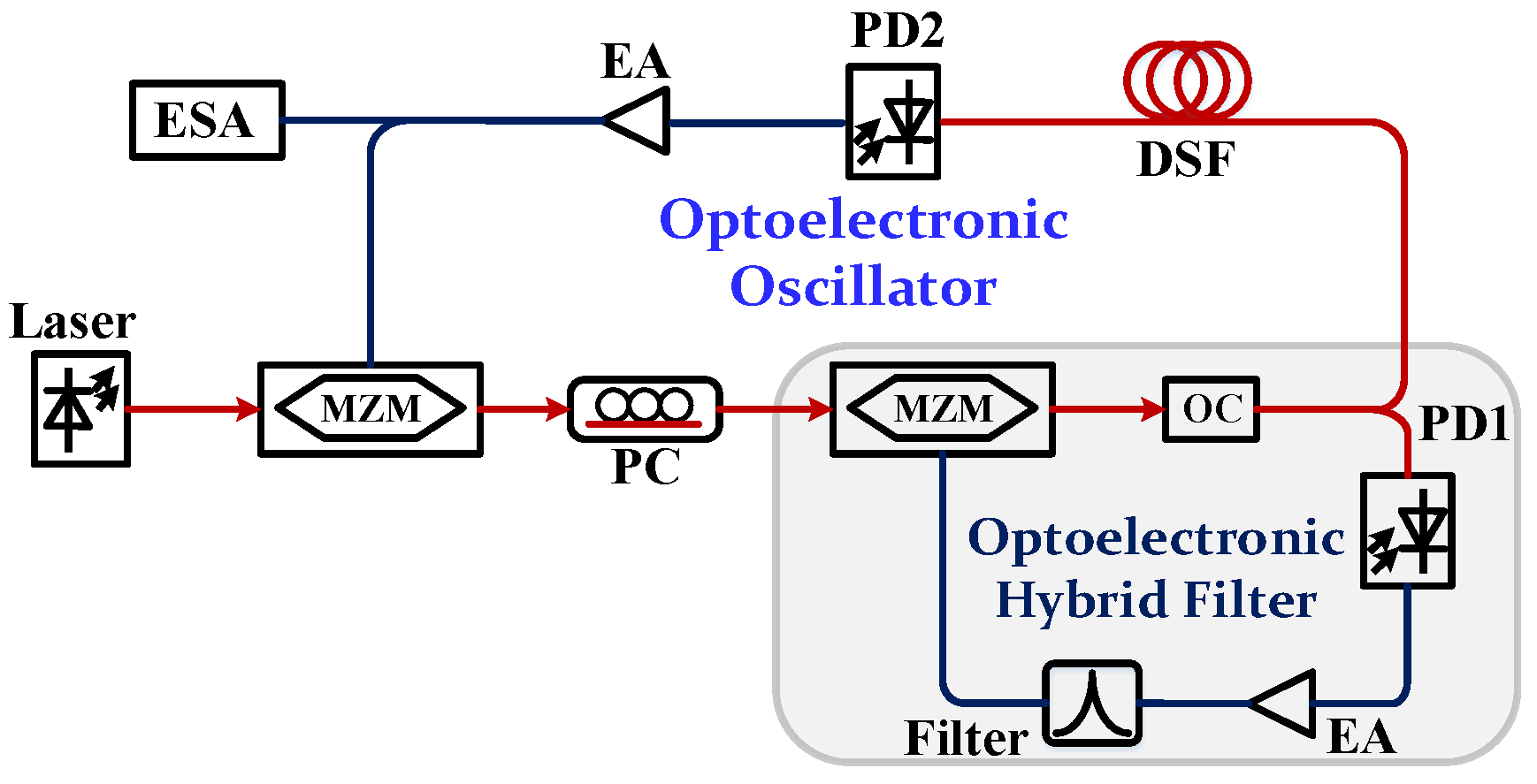
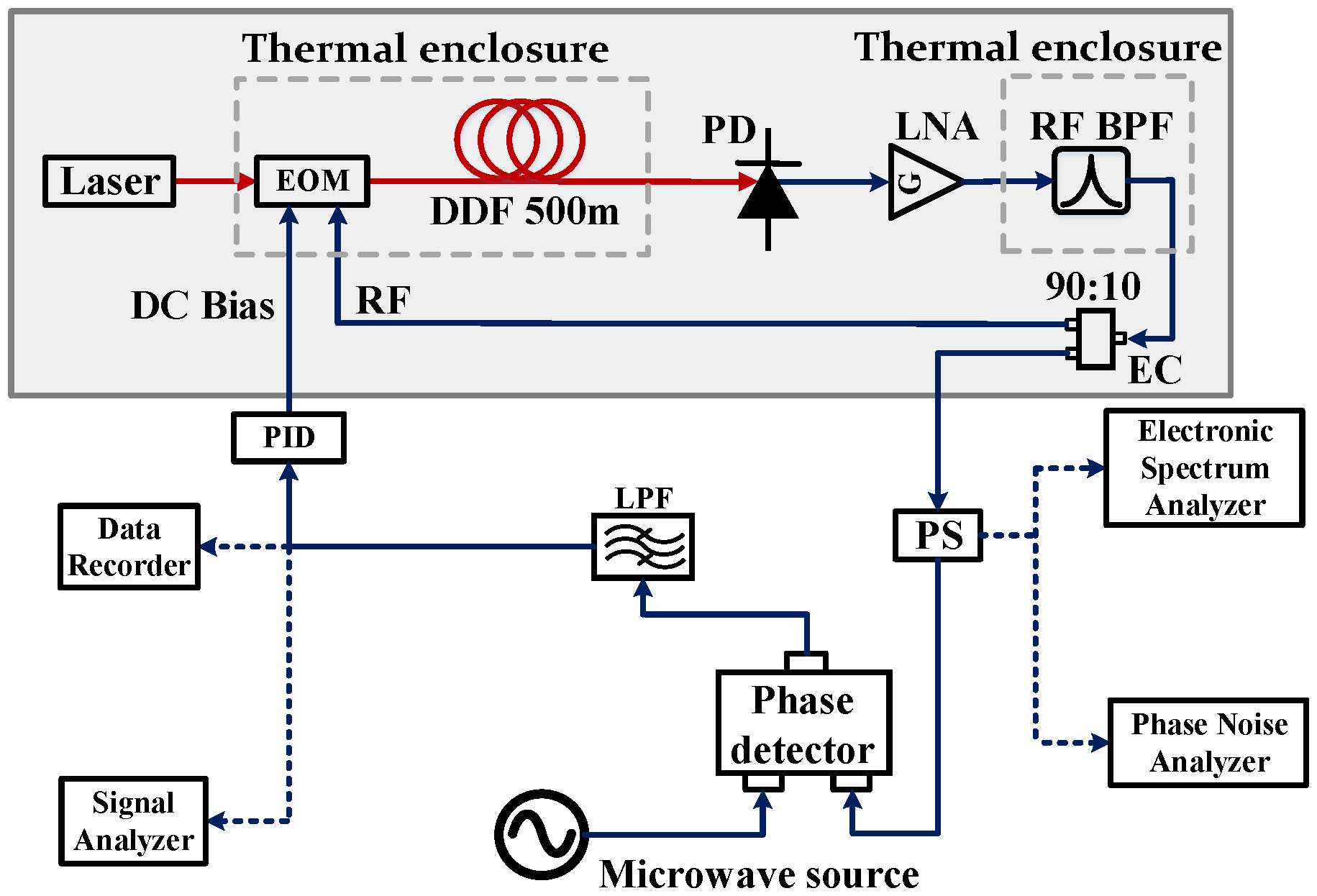

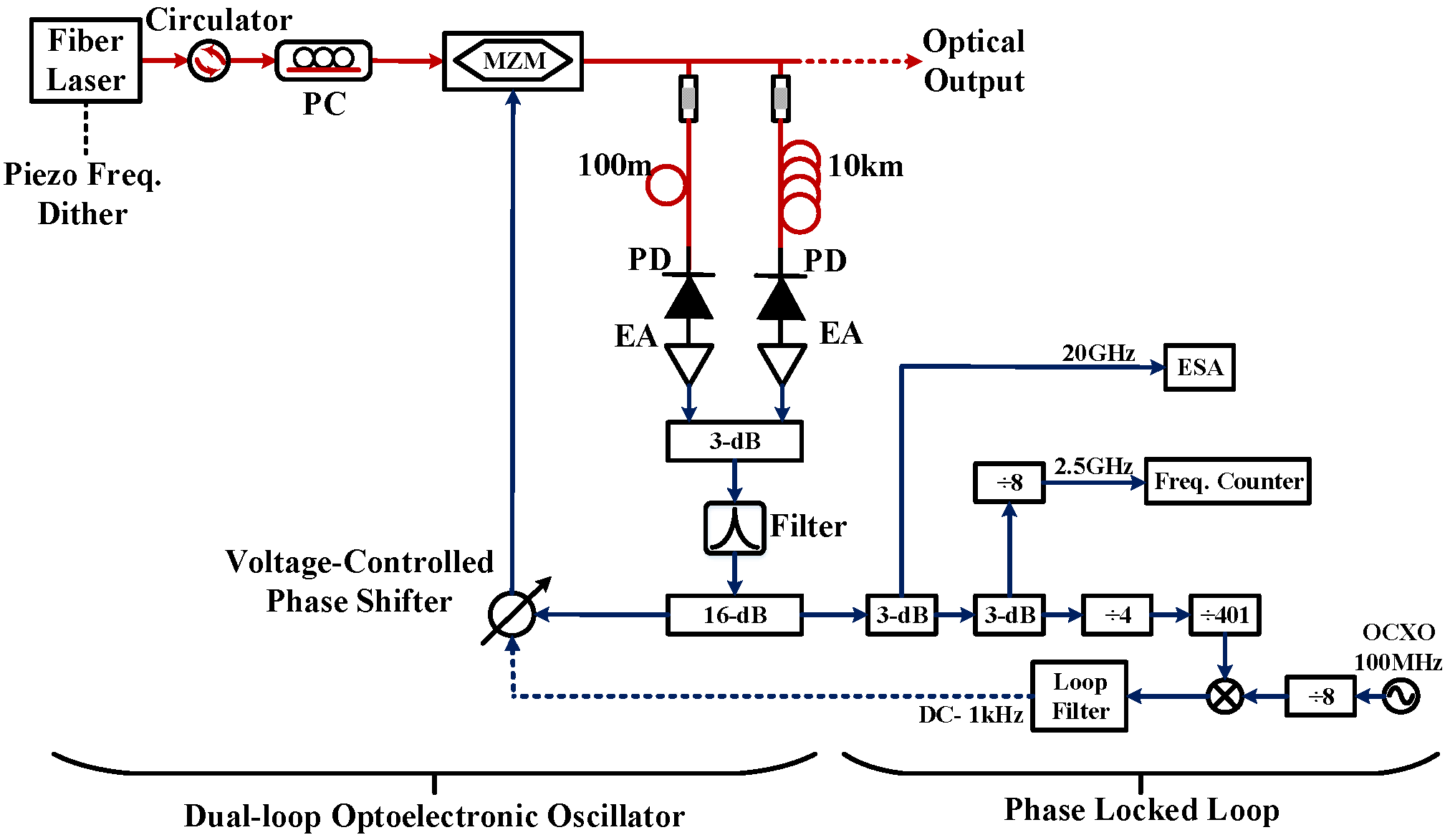
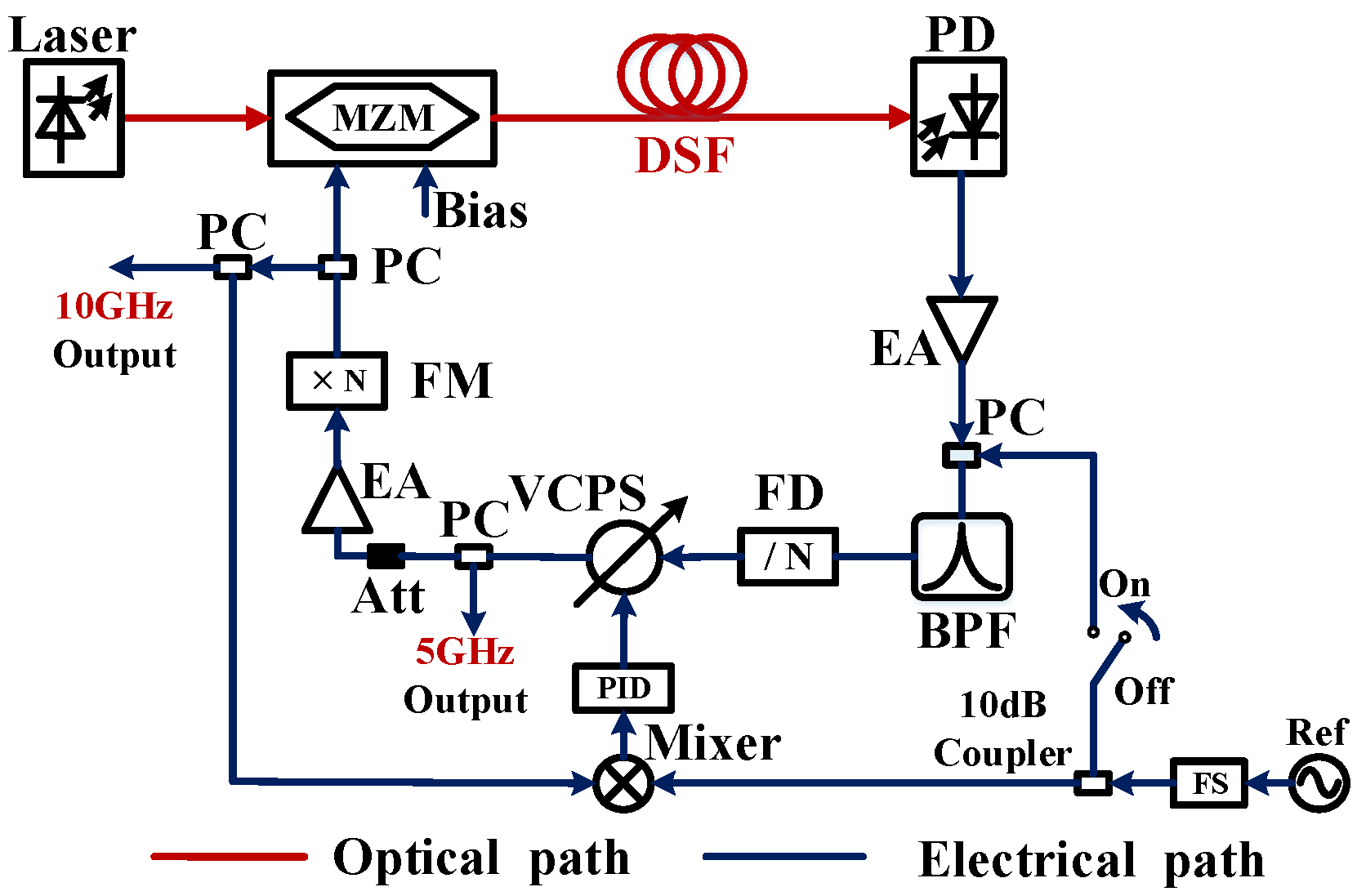
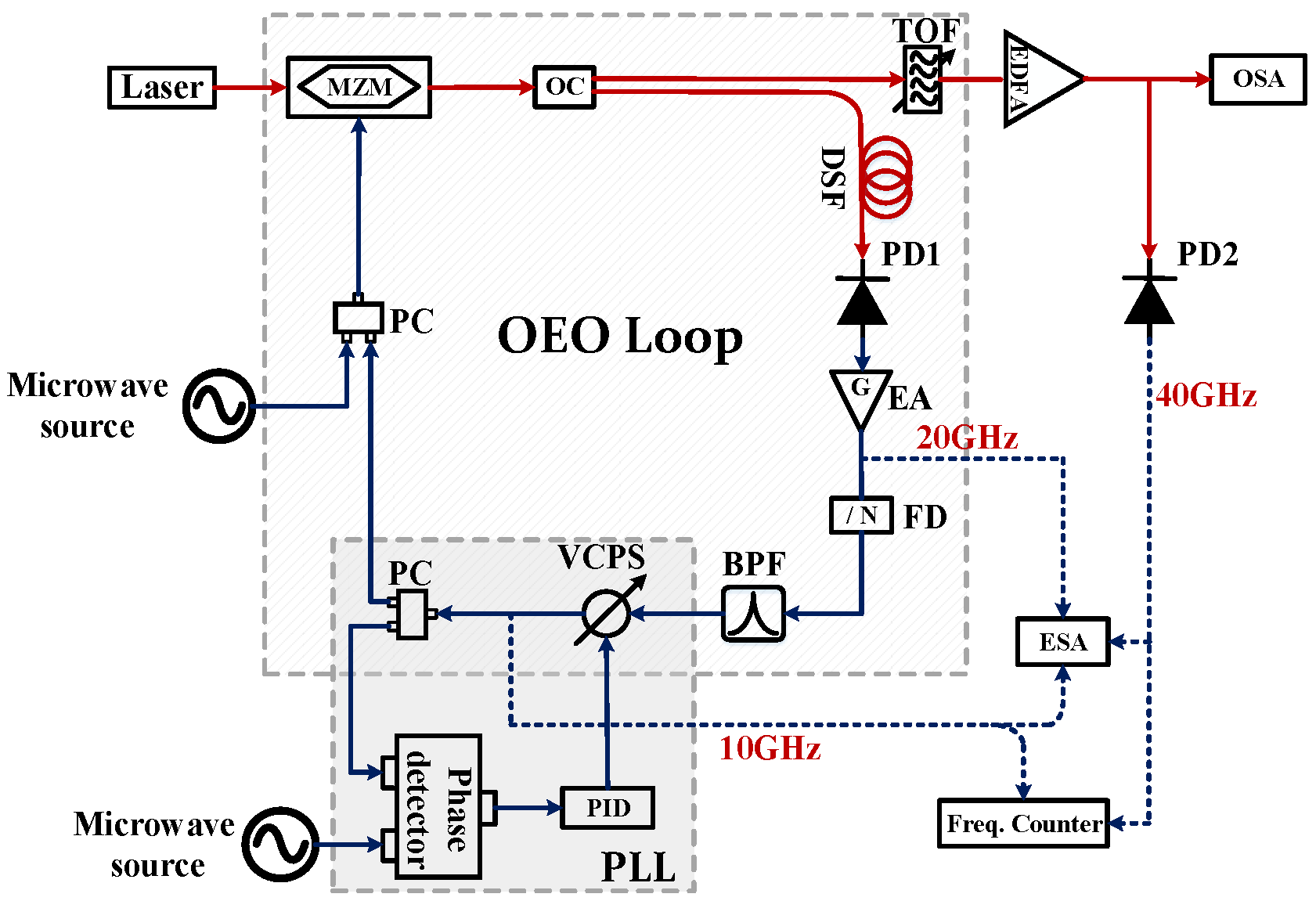
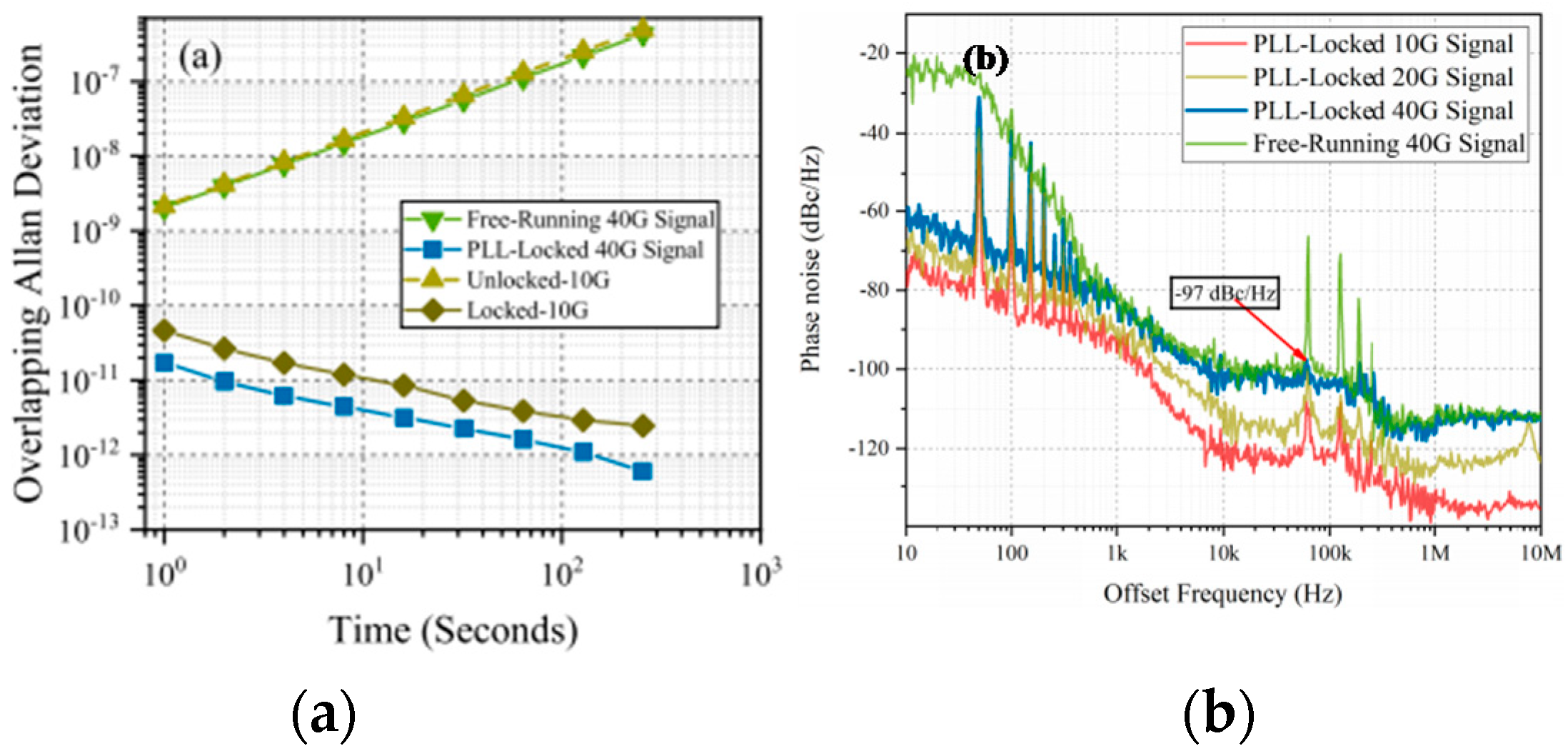
© 2018 by the authors. Licensee MDPI, Basel, Switzerland. This article is an open access article distributed under the terms and conditions of the Creative Commons Attribution (CC BY) license (http://creativecommons.org/licenses/by/4.0/).
Share and Cite
Liu, A.; Dai, J.; Xu, K. Stable and Low-Spurs Optoelectronic Oscillators: A Review. Appl. Sci. 2018, 8, 2623. https://doi.org/10.3390/app8122623
Liu A, Dai J, Xu K. Stable and Low-Spurs Optoelectronic Oscillators: A Review. Applied Sciences. 2018; 8(12):2623. https://doi.org/10.3390/app8122623
Chicago/Turabian StyleLiu, Anni, Jian Dai, and Kun Xu. 2018. "Stable and Low-Spurs Optoelectronic Oscillators: A Review" Applied Sciences 8, no. 12: 2623. https://doi.org/10.3390/app8122623
APA StyleLiu, A., Dai, J., & Xu, K. (2018). Stable and Low-Spurs Optoelectronic Oscillators: A Review. Applied Sciences, 8(12), 2623. https://doi.org/10.3390/app8122623




